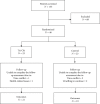Effect of Tai Chi Training on Plantar Loads during Walking in Individuals with Knee Osteoarthritis
- PMID: 32258112
- PMCID: PMC7079237
- DOI: 10.1155/2020/3096237
Effect of Tai Chi Training on Plantar Loads during Walking in Individuals with Knee Osteoarthritis
Abstract
Tai Chi is an available method for the treatment of knee osteoarthritis (KOA). The impacts of Tai Chi on plantar loads of individuals with KOA are not fully understood. 46 participants with knee osteoarthritis were randomly assigned into the Tai Chi group (n = 23) or the control group (n = 23). The Tai Chi group attended a 6-month Tai Chi program, and the control group participated in a wellness education program. Novel Pedar-X system was used to collect the peak pressure (PP) and maximum force (MF) during walking before and 6 months after the intervention. Significant higher peak pressure and maximum force were observed in the 4th and 5th metatarsophalangeal joints in the Tai Chi group. However, there were significant declines in the peak pressure of the whole foot and the 2nd and 3rd metatarsophalangeal joints and maximum force of the heel in the control group. These results suggested that individuals with KOA might change the pattern of plantar loads during walking through Tai Chi, and plantar loads would be useful as a parameter to assess the effect of Tai Chi on knee osteoarthritis. This trial is registered with Clinical Trials: CHiCTR-TRC-13003264.
Copyright © 2020 Zhiwang Zhang et al.
Conflict of interest statement
The authors declare that there is no conflict of interest regarding the publication of this paper.
Figures


References
-
- Wang C., Iversen M. D., McAlindon T., et al. Assessing the comparative effectiveness of tai chi versus physical therapy for knee osteoarthritis: design and rationale for a randomized trial. BMC Complementary and Alternative Medicine. 2014;14(1):p. 333. doi: 10.1186/1472-6882-14-333. - DOI - PMC - PubMed
Publication types
MeSH terms
LinkOut - more resources
Full Text Sources
Miscellaneous

